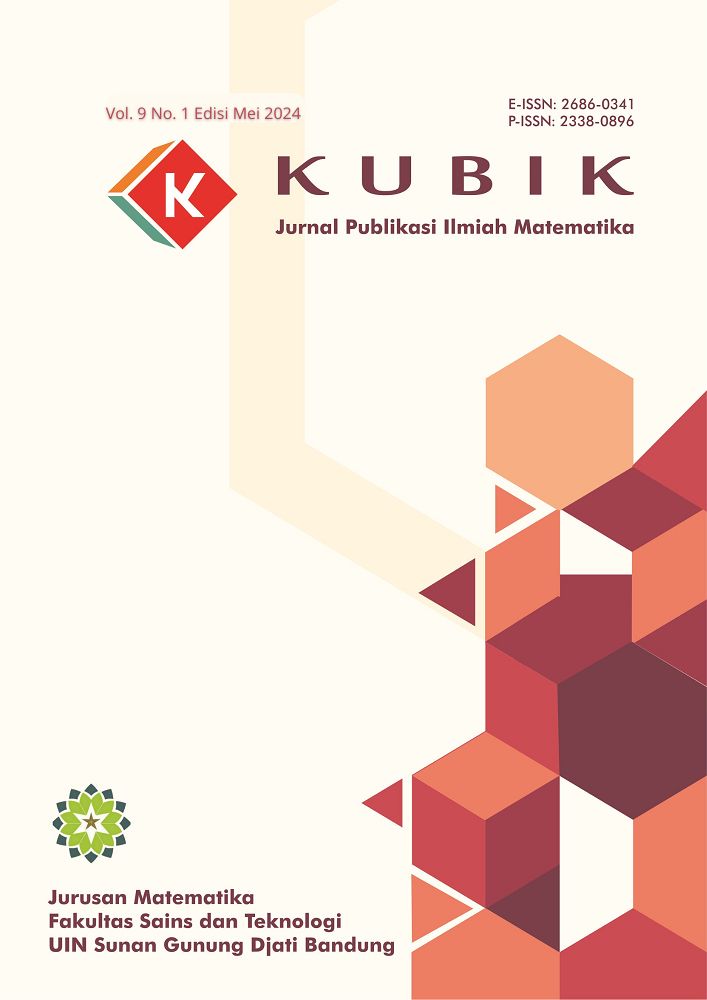Traffic Modeling in Serang City Using the Extended Link Transmission Model
DOI:
https://doi.org/10.15575/kubik.v9i1.34720Keywords:
link transmission model, LTM model, traffic modelingAbstract
In many countries, traffic problem has increased time by time, it has been caused by the increasing amount of vehicle and the lacking of segment road. For the example, urban traffic problem such as traffic congestion has become a big problem for drivers. This research studied urban traffic modeling using the link transmission model (LTM). The method was proposed is mathematical modeling, including car and bus as the objects of research. The cars and buses data were collected directly by the observers at the intersection that has four links and that are connected each other. The simulation process was obtained for the each link at rush hour period. At the interval 6.30-7.30am the total time spend in the link A, B, C, and D were 45.93h, 28.58h, 37.25h, and 19.91h. At the interval 04.00-05.00pm the total time spend in the link A, B, C, and D were 27.38h, 28.58h, 37.25h, and 19.91h. Based on these results, we might to give an advice to control the duration of  traffic lights that controlled traffic flow in the each link. The red traffic light duration of link A at 6.30-730am must be lower than the others so the vehicles at link A will send much better and the TTS will turn down.
References
S. Dorokhin, D. Likhachev, A. Artemov, A. Sevostyanov, A. Kulikov, and A. Novikov, “The Dynamic Traffic Modelling System BT - International Scientific Siberian Transport Forum TransSiberia - 2021,†A. Manakov and A. Edigarian, Eds., Cham: Springer International Publishing, pp. 1586–1594, 2022.
J. Navarro-Ortiz, P. Romero-Diaz, S. Sendra, P. Ameigeiras, J. J. Ramos-Munoz, and J. M. Lopez-Soler, “A Survey on 5G Usage Scenarios and Traffic Models,†IEEE Commun. Surv. Tutorials, Vol. 22, No. 2, pp. 905–929, 2020, doi: 10.1109/COMST.2020.2971781.
M. Alexandro, M. Gloria, and C. Fernando, “Complete Street strategies in cycleways applied in district with high delivery demand to reduce travel costs,†in 2022 Congreso Internacional de Innovación y Tendencias en IngenierÃa (CONIITI), pp. 1–6, 2022. doi: 10.1109/CONIITI57704.2022.9953729.
V. Jain, A. Sharma, and L. Subramanian, “Road traffic congestion in the developing world,†in Proceedings of the 2nd ACM Symposium on Computing for Development, in ACM DEV ’12. New York, NY, USA: Association for Computing Machinery, 2012, doi: 10.1145/2160601.2160616.
M. Sweet, “Does Traffic Congestion Slow the Economy?,†J. Plan. Lit., Vol. 26, No. 4, pp. 391–404, 2011, doi: 10.1177/0885412211409754.
D. K. N. Rachim, Salmah, and I. Solekhudin, “Link transmission model involving multi class vehicle,†Proc. 2017 5th Int. Conf. Instrumentation, Control. Autom. ICA 2017, pp. 158–162, 2017, doi: 10.1109/ICA.2017.8068432.
A.H. F. Chow, A. Santacreu, I. Tsapakis, G. Tanasaranond, and T. Cheng, “Empirical assessment of urban traffic congestion,†J. Adv. Transp., Vol. 48, No. 8, pp. 1000–1016, 2014, doi: https://doi.org/10.1002/atr.1241.
F. Muhtarulloh, E. W. Mardiah, and A. F. Huda, “Penyelesaian Masalah Transportasi dengan Degenerasi dan Siklus Berulang Menggunakan Minimum Demand Method dan Maximum Difference Extreme Difference Method,†KUBIK: Jurnal Publikasi Ilmiah Matematika, Vol. 8, No. 1, pp. 35-43, 2023, https://doi.org/10.15575/kubik.v8i1.
M. Rohmah, E. R. Wulan, and F. Ilahi, “Penentuan Rute Transportasi untuk Meminimalkan Biaya Menggunakan Metode Nearest Neighbor dan Nearest Insert (Studi Kasus dalam Pendistribusian Sandal di Tasikmalaya),†KUBIK: Jurnal Publikasi Ilmiah Matematika, Vol. 4, No. 2, pp. 187–194, 2019.
Y. Cao and D. Sun, “Link Transmission Model for Air Traffic Flow Management,†J. Guid. Control. Dyn., Vol. 34, No. 5, pp. 1342–1351, 2011, doi: 10.2514/1.51495.
G. Gentile, “Using the General Link Transmission Model in a Dynamic Traffic Assignment to Simulate Congestion on Urban Networks,†Transp. Res. Procedia, Vol. 5, pp. 66–81, 2015, doi: https://doi.org/10.1016/j.trpro.2015.01.011.
M. C. J. Bliemer, and M. P. H. Raadsen, “Continuous-time general link transmission model with simplified fanning, Part I: Theory and link model formulation,†Transp. Res. Part B Methodol., Vol. 126, pp. 442–470, 2019, doi: 10.1016/j.trb.2018.01.001.
G. S. van de Weg, M. Keyvan-Ekbatani, A. Hegyi, and S. P. Hoogendoorn, “Linear MPC-Based Urban Traffic Control Using the Link Transmission Model,†IEEE Trans. Intell. Transp. Syst., Vol. 21, No. 10, pp. 4133–4148, 2020, doi: 10.1109/TITS.2019.2938795.
G. B. Whitham, “On kinematic waves II. A theory of traffic flow on long crowded roads,†Proc. R. Soc. London. Ser. A. Math. Phys. Sci., Vol. 229, No. 1178, pp. 317–345, 1955, doi: 10.1098/rspa.1955.0089.
P. I. Richards, “Shock waves on the highway,†Oper. Res., Vol. 4, No. 1, pp. 42–51, 1956.
I. Yperman, “The link transmission model for dynamic network loading,†Kathol. Univ. Leuven, Vol. 481, p. 482, 2007.
Downloads
Published
How to Cite
Issue
Section
Citation Check
License
Authors who publish in KUBIK: Jurnal Publikasi Ilmiah Matematika agree to the following terms:
- Authors retain copyright and grant the journal right of first publication with the work simultaneously licensed under a Attribution-ShareAlike 4.0 International (CC BY-SA 4.0) License that allows others to share the work with an acknowledgment of the work's authorship and initial publication in this journal.
- Authors are able to enter into separate, additional contractual arrangements for the non-exclusive distribution of the journal's published version of the work (e.g., post it to an institutional repository or publish it in a book), with an acknowledgment of its initial publication in this journal.
- Authors are permitted and encouraged to post their work online (e.g., in institutional repositories or on their website) prior to and during the submission process, as it can lead to productive exchanges, as well as earlier and greater citation of published work (See The Effect of Open Access).
Â









